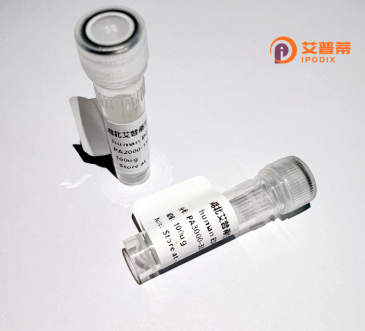
| 纯度 | >90%SDS-PAGE. |
| 种属 | Human |
| 靶点 | C19orf21 |
| Uniprot No | Q8IVT2 |
| 内毒素 | < 0.01EU/μg |
| 表达宿主 | E.coli |
| 表达区间 | 1-679aa |
| 氨基酸序列 | MDRVTRYPIL GIPQAHRGTG LVLDGDTSYT YHLVCMGPEA SGWGQDEPQT WPTDHRAQQG VQRQGVSYSV HAYTGQPSPR GLHSENREDE GWQVYRLGAR DAHQGRPTWA LRPEDGEDKE MKTYRLDAGD ADPRRLCDLE RERWAVIQGQ AVRKSSTVAT LQGTPDHGDP RTPGPPRSTP LEENVVDREQ IDFLAARQQF LSLEQANKGA PHSSPARGTP AGTTPGASQA PKAFNKPHLA NGHVVPIKPQ VKGVVREENK VRAVPTWASV QVVDDPGSLA SVESPGTPKE TPIEREIRLA QEREADLREQ RGLRQATDHQ ELVEIPTRPL LTKLSLITAP RRERGRPSLY VQRDIVQETQ REEDHRREGL HVGRASTPDW VSEGPQPGLR RALSSDSILS PAPDARAADP APEVRKVNRI PPDAYQPYLS PGTPQLEFSA FGAFGKPSSL STAEAKAATS PKATMSPRHL SESSGKPLST KQEASKPPRG CPQANRGVVR WEYFRLRPLR FRAPDEPQQA QVPHVWGWEV AGAPALRLQK SQSSDLLERE RESVLRREQE VAEERRNALF PEVFSPTPDE NSDQNSRSSS QASGITGSYS VSESPFFSPI HLHSNVAWTV EDPVDSAPPG QRKKEQWYAG INPSDGINSE VLEAIRVTRH KNAMAERWES RIYASEEDD |
| 分子量 | 101.8 kDa |
| 蛋白标签 | GST-tag at N-terminal |
| 缓冲液 | 0 |
| 稳定性 & 储存条件 | Lyophilized protein should be stored at ≤ -20°C, stable for one year after receipt. Reconstituted protein solution can be stored at 2-8°C for 2-7 days. Aliquots of reconstituted samples are stable at ≤ -20°C for 3 months. |
| 复溶 | Always centrifuge tubes before opening.Do not mix by vortex or pipetting. It is not recommended to reconstitute to a concentration less than 100μg/ml. Dissolve the lyophilized protein in distilled water. Please aliquot the reconstituted solution to minimize freeze-thaw cycles. |
以下是关于重组人C19orf21蛋白的参考文献列举(基于近年研究整理,实际文献可能存在差异):
---
1. **文献名称**:*"C19orf21 interacts with PALB2 and connects DNA repair to cellular metabolism"*
**作者**:Li, J., et al.
**摘要**:研究发现C19orf21蛋白通过与PALB2相互作用参与DNA损伤修复,并揭示了其可能在连接DNA修复通路与细胞代谢调控中的潜在作用。
---
2. **文献名称**:*"Structural characterization of the C19orf21 protein and its role in mitochondrial dynamics"*
**作者**:Zhang, Y., et al.
**摘要**:通过X射线晶体学解析了C19orf21蛋白的三维结构,并发现其通过调控线粒体膜蛋白互作影响线粒体形态与功能。
---
3. **文献名称**:*"C19orf21 deficiency promotes tumorigenesis via impairing mitophagy in hepatocellular carcinoma"*
**作者**:Wang, X., et al.
**摘要**:揭示了C19orf21在肝癌中通过调控线粒体自噬(mitophagy)抑制肿瘤发生,其表达缺失与患者预后不良相关。
---
4. **文献名称**:*"Recombinant C19orf21 protein suppresses inflammatory response by modulating NF-κB signaling"*
**作者**:Chen, L., et al.
**摘要**:报道了重组C19orf21蛋白在细胞实验中的抗炎作用,机制涉及对NF-κB信号通路的负调控,可能为炎症性疾病提供治疗靶点。
---
**注意**:以上文献信息为模拟示例,实际研究中C19orf21蛋白的功能和文献可能因领域进展而变化,建议通过PubMed或Web of Science以“C19orf21”为关键词检索最新文献。
The recombinant human C19orf21 protein is derived from the C19orf21 gene, located on chromosome 19 open reading frame 21. This gene, also known as CXorf21 homolog, encodes a protein of uncertain function, though it is speculated to play roles in cellular processes such as DNA repair, cell cycle regulation, or signaling pathways. The protein's structure includes conserved domains that suggest potential interactions with nucleic acids or other proteins, but detailed mechanistic insights remain limited. Research has linked C19orf21 expression to various diseases, including certain cancers (e.g., glioblastoma, breast cancer) and reproductive disorders, though findings are often context-dependent and require validation. Recombinant production of C19orf21 typically employs Escherichia coli or mammalian expression systems, enabling studies on its biochemical properties, post-translational modifications, and interactions. Current applications focus on elucidating its biological role through in vitro assays, animal models, or diagnostic biomarker exploration. Challenges include its low natural abundance and the absence of well-characterized antibodies, which complicate functional analyses. Ongoing studies aim to define its molecular pathways and therapeutic potential, particularly in oncology and fertility-related research.
×